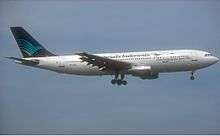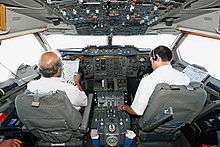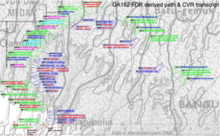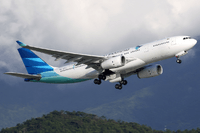Garuda Indonesia Flight 152
Garuda Indonesia Flight 152 was a scheduled domestic Indonesian passenger flight from Soekarno-Hatta International Airport in Jakarta to Polonia International Airport in Medan, North Sumatra, operated by Garuda Indonesia using an Airbus A300B4 registered PK-GAI.
 A Garuda Indonesia Airbus A300, similar to the aircraft involved in the accident | |
| Accident | |
|---|---|
| Date | 26 September 1997 |
| Summary | Controlled flight into terrain due to pilot error, ATC error, and GPWS malfunction |
| Site | Near Pancur Batu, Deli Serdang, North Sumatra, Indonesia 03°20′28.2″N 98°34′26.6″E |
| Aircraft | |
| Aircraft type | Airbus A300B4-220 |
| Operator | Garuda Indonesia |
| IATA flight No. | GA152 |
| ICAO flight No. | GIA152 |
| Call sign | INDONESIA 152 |
| Registration | PK-GAI |
| Flight origin | Soekarno-Hatta Int'l Airport, Jakarta, Indonesia |
| Destination | Polonia Int'l Airport, Medan, Indonesia |
| Occupants | 234 |
| Passengers | 222 |
| Crew | 12 |
| Fatalities | 234 |
| Survivors | 0 |
On 26 September 1997, Flight 152, on final approach into Polonia International Airport, crashed into mountainous woodlands 30 miles (48 km) from Medan during low visibility caused by the 1997 Southeast Asian haze. All 222 passengers and 12 crew were killed. The crash site was in a ravine near the village of Buah Nabar in the Sibolangit district south of Medan.[1] With 234 fatalities, it is the deadliest airline disaster in Indonesia's history.[2][3] It is also the fourth-deadliest aviation disaster involving an Airbus A300, after China Airlines Flight 140, American Airlines Flight 587, and Iran Air Flight 655.[4]
Aircraft type

The aircraft was an Airbus A300B4 FFCC, or "forward-facing crew concept." The FFCC model is a modified version of the A300B4 in which the flight engineer station is eliminated, and the relevant controls are simplified and relocated to be positioned on the overhead panel between the two pilots. This control arrangement is similar to the Airbus A310 series, the difference being that the FFCC retains most of the analogue flight instrumentation of the original A300. The FFCC would later be developed into the A300-600 series, in which all elements of the flight deck are brought to A310 standards, including the addition of electronic flight instrumentation. The two pilots aboard the accident flight were qualified to fly both the FFCC and the -600 model, however the adequacy of their conversion training between the two would later be called into question.
Aside from being an FFCC model, the aircraft was powered by two Pratt & Whitney JT9D-59A turbofan engines and had flown 26,950 hours (over 16,500 take-off and landing cycles) at the time of the accident.[5][6]
Accident

At approximately 1:00pm, air traffic controllers in Medan cleared Flight 152 for an ILS approach into Runway 05 from its current 316 degree heading. The crew, led by Captain Rahmo Wiyogo, 41, a pilot with over 20 years of flying experience at Garuda Indonesia and more than 12,000 flying hours, and First Officer Tata Zuwaldi, also 41, a former flight engineer who recently upgraded to pilot, was instructed to turn left heading 240 degrees to intercept the ILS localizer. 120 seconds prior to impact, the crew was asked to turn left further, to 215 degrees, and descend to 2000 feet. At 1:30pm, Medan directed the flight to turn right heading 046 degrees to line up for arrival into Runway 05, and asked the crew to report the direction in which the plane was travelling. Air traffic controllers then became confused as to which plane they were talking to, as another flight with the same number (Merpati Nusantara Airlines Flight 152) was also in the area at the time.
.jpg)
Earlier in the day, another Flight 152, Merpati Nusantara Airlines Flight 152, was handled by the same air traffic controller. This led to the controller mistakenly saying "Merpati one five two turn left heading 240 to intercept runway zero five from the right side"; as the wrong call sign was used, the Garuda pilots had no need to absorb these instructions. The controller, on not receiving a response, queried the pilots to get their attention, this time using the correct call sign, "Indonesia 152". The controller then repeated most of his instructions, specifically failing to repeat that the flight would be making its approach on the south side of the runway, or right side. The pilots believed they were flying the approach on the north side of the airport, which reflected the information on the approach chart the pilots were using. Thus, when the pilots were instructed to turn right to a heading of 046 maintaining 2,000 ft to capture the localizer for the ILS to Runway 05, out of habit – or possibly due to the detailed approach chart – the captain initiated a left turn to a heading of 046. The First Officer was distracted during the turn and did not notice for a while that the aircraft was turning left. When he did notice, he told the captain he was turning the wrong way, and the captain questioned the controller over which way they needed to turn, to which the controller confirmed they were to turn right. A confusing conversation took place over which way to turn, with the controller not having a clear picture of what the flight was doing, due to being unaware that he had left out some critical instructions after his "Merpati 152" mistake and due to the Medan radar system having a refresh time of 12 seconds.
Without a constant up-to-date view over the flight's heading, the controller thought the plane was continuing left, when it was actually turning right and over high terrain. During this time the flight descended through 2,000 ft due to the captain inputting the wrong altitude of 1,500 ft. The pilots did not notice this due to the poor visibility from the 1997 Southeast Asian haze.[7] Five seconds prior to initial impact with the treetops, the First Officer made a comment about the airplane's altitude. The FDR recorded increases in pitch and engine power, likely commanded by the crew in an effort to correct their altitude. Shortly before the recording ended, the cockpit voice recorder registered the sound of the plane striking trees, followed by shouting from the pilots. The aircraft crashed into high terrain 45 km from the Runway 05 threshold, 18 km to the south of the center line. The aircraft hit the ground at 1:34 p.m., right wing low, turning towards the airport in the process at a heading of 311 degrees and an altitude of 1,510 ft MSL. All 234 people on board died.
Victims
The passengers were mostly Indonesian, with six Japanese, four German, three Taiwanese, two American, two British, two Canadian, one Australian, one Belgian, one Dutch, one French, one Italian, one Malaysian, and one Swedish national.[8][9]
Nationalities of the passengers and crew
| Nationality | Passengers | Crew | Total |
|---|---|---|---|
| Indonesia | 198 | 12 | 210 |
| Japan | 6 | 0 | 6 |
| Germany | 4 | 0 | 4 |
| Taiwan | 3 | 0 | 3 |
| Canada | 2 | 0 | 2 |
| United States | 2 | 0 | 2 |
| United Kingdom | 2 | 0 | 2 |
| France | 1 | 0 | 1 |
| Italy | 1 | 0 | 1 |
| Malaysia | 1 | 0 | 1 |
| Netherlands | 1 | 0 | 1 |
| Australia | 1 | 0 | 1 |
| Sweden | 1 | 0 | 1 |
| Belgium | 1 | 0 | 1 |
| Total | 222 | 12 | 234 |
Passenger remains
Forty-eight of the bodies recovered from the crash were never identified and were buried in a mass grave in a cemetery outside Medan's Polonia Airport, where 61 victims of the 1979 Garuda Fokker F28 crash were also buried. The remaining 186 bodies were identified and returned to their families for private burial.[10]
Notable passengers
One of the passengers killed in the crash was businessman Yanto Tanoto, the president director of pulp and rayon company PT Inti Indorayon Utama Polar, and the younger brother of Sukanto Tanoto.[11][12][13]
Investigation
The causes of the crash, according to the official report of the National Transportation Safety Committee (NTSC), were:
"There was confusion regarding turning direction of left turn instead of right turn at critical position during radar vectoring that reduced the flight crew’s vertical awareness while they were concentrating on the aircraft’s lateral changes. These caused the aircraft to continue descending below the assigned altitude of 2000 ft and hit treetops at 1550 ft above mean sea level."[14]
The Report also criticized the airline's conversion training for pilots who fly both the A300-600 and A300B4-FF models. The former is equipped with digital navigation displays, while the latter is equipped with analog equipment. Though both are sufficient for conducting instrument approaches, the captain may have been overwhelmed due to his lack of familiarity with the analog instrumentation.[14]
Contributing to the accident was the failure of the Ground Proximity Warning System (GPWS) for undetermined reasons and the inadequate vectoring charts used by the controllers at Medan.[14]
Lawsuits
The first lawsuit was filed by Nolan Law Group in Chicago, Illinois on September 24, 1998 on behalf of American passengers Fritz and Djoeminah Baden.[15] Additional lawsuits were filed in state and federal courts in Chicago related to many more victims from Indonesia, Germany, Britain, Italy, and Australia. The sole defendant in the lawsuits was Sundstrand Corporation (later Hamilton Sundstrand), the company that designed and manufactured the Mark-II ground proximity warning system ("GPWS") installed on the Airbus A300. The plaintiffs alleged that the GPWS was defectively designed, that the manufacturer was aware of its deficiencies in mountainous terrain for over a decade, and had the system worked as designed the accident could have been avoided. Had the aircraft been fitted with EGPWS the crew would have had the alarm sound between 18 and 23 seconds before impact; the accident would have been avoided.
The victims' lawyers produced several internal memos from Hamilton-Sundstrand showing that the system had been inadequately tested for mountainous terrain, having been mostly tested on flat ground with gentle slopes. Perhaps the most critical memo was one written by Hamilton-Sundstrand engineer Donald Bateman, who wrote:
"Based on recent flight demonstrations ... of the MK II GPWS, I have become very concerned about the Excessive Rate Detector Circuits in the MK II computers. I believe we have a much more potentially serious problem than was first envisioned in 1982. GPWS warnings can be short or non-existent in some circumstances." Bateman's memo went on to say that "the warning time for flight into mountainous terrain and steep descent rates from altitudes above the range of the radio altimeter can be very short and erratic at times ... From our studies, the average escape margin is only three-and-one-half seconds for the typical mountainous-terrain accident scenario."
Sundstrand's in-house experts conducted their own after-crash simulations and confirmed that a properly functioning warning system should have sounded alarms about 14 seconds before impact and that the accident would have been avoided if that had occurred.
Nearly six years after the crash the lawsuit was settled out of court.[16]
In Coyle v. P.T. Garuda Indonesia,[17] Joyce Coyle filed a suit in the U.S. District Court for the District of Oregon against the Indonesian government subsidiary that operates Garuda Indonesia Airlines. Coyle alleged in her complaint that Garuda was liable for wrongful death under the Warsaw Convention. She also claimed that Garuda, which is wholly owned by the Indonesian government, could be held liable under two exceptions to the Foreign Sovereign Immunities Act. She contended that because Garuda was authorized to operate in the United States at the time, the immunity had been explicitly waived under the rules of the Department of Transportation, which requires foreign air carriers to open themselves to suit in the United States as a condition of being allowed to fly to, from, or within this country. The waiver is limited to actions arising under treaties. Coyle also claimed that by selling tickets in the United States, Garuda waived immunity under the "commercial activity" exception to the FSIA. U.S. District Judge Robert E. Jones denied Garuda's motion to dismiss, adopting a magistrate judge's conclusion that the trip to Medan was "one leg of an international journey" and thus subject to the Warsaw Convention and the explicit waiver of immunity.
On appeal to the U.S. Court of Appeals for the Ninth Circuit, Circuit Judge Diarmuid F. O’Scannlain, writing for a unanimous three-judge panel, rejected Garuda's claim that a flight between two points in the same country will always fall outside the scope of the waiver. But the Ninth Circuit agreed with Garuda that under the circumstances, the Badens’ trip to Medan did not constitute "international air transportation" within the meaning of the Warsaw Convention. The facts that the tickets did not reference any international travel, were purchased in Indonesia from a source independent of the travel agent who sold them the U.S.-Indonesia tickets, and were labeled "DOMESTIK" unambiguously established that the flight was not part of their international journey as contemplated by the treaty, O’Scannlain said.
The court explained:
"[T]he crux of this litigation is whether Flight 152 was a part of [the] larger international trip for purposes of the Warsaw Convention...whether it was a component of 'one undivided transportation...regarded by the parties as a single operation'...or just a late-added, purely domestic side trip apart from their international itinerary with its own final destination. The Badens' tickets for Flight 152 are powerful, unambiguous evidence of the latter."
Nor was the court persuaded by Coyle's "commercial activity" argument. For the exception to apply, O’Scannlain noted, the statute requires that the action arise from “a commercial activity carried on in the United States by the foreign state...or upon an act outside the territory of the United States in connection with a commercial activity of the foreign state elsewhere [when such] act causes a direct effect in the United States.” The fact that Garuda sold tickets in the United States did not furnish a sufficient nexus to subject its domestic flights to the exception, the judge wrote. Senior Judge Ferdinand F. Fernandez and Judge Raymond C. Fisher joined in the opinion that ended Coyle's suit.
It is uncertain if any lawsuits made reference to the air traffic controller giving instructions and information to the wrong airplane, then leaving out some of that information when he finally repeated it to the crew of the accident plane.
Current registration
Garuda Indonesia's fleet of ATR 72-600 aircraft use the same registration numbers as their previous fleet of Airbus A300, meaning that the registration PK-GAI was passed on to an in-service ATR 72-600.
In popular culture
The crash of Garuda Indonesia Flight 152 is featured in the fifth episode of the Season 17 of Mayday (Air Crash Investigation). The episode is titled "Lethal Turn".
Aftermath
Garuda Indonesia now uses the flight number GA186 on this route, while GA152, is now used on the Jakarta - Batam route. The airline uses Boeing 737-800 aircraft for both routes.
See also
- List of accidents and incidents involving commercial aircraft
- 1997 Southeast Asian haze
- 1997 Indonesian forest fires
- Alitalia Flight 404, another plane crash on approach when the GPWS didn't sound
Notes
- "Accident Photo: Garuda Indonesia 152 – Airbus A300 PK-GAI". AirDisaster.Com. September 26, 1997. Archived from the original on May 15, 2014. Retrieved January 13, 2014.
- Ranter, Harro. "ASN Aircraft accident Airbus A300B4-220 PK-GAI Medan-Polonia Airport (MES)". aviation-safety.net. Aviation Safety Network. Retrieved May 1, 2019.
- Ranter, Harro. "Indonesia air safety profile". aviation-safety.net. Aviation Safety Network. Retrieved May 1, 2019.
- Ranter, Harro. "Airbus A300". aviation-safety.net. Aviation Safety Network. Retrieved September 27, 2019.
- "Garuda PK-GAI (Airbus A300 - MSN 214)". www.airfleets.net. Airfleets aviation. Retrieved July 9, 2019.
- "PK-GAI Garuda Indonesia Airbus A300B4". www.planespotters.net. Retrieved July 9, 2019.
- Mydans, Seth (September 27, 1997). "Indonesia Jet Crash Kills All 234 Aboard; Haze Was a Possible Cause". The New York Times. ISSN 0362-4331. Retrieved October 21, 2016.
- "Indonesia: Investigators Look At Possible Effect Of Smog On Garuda Airlines Airbus Crash". itnsource.com. Reuters. September 27, 1997. Archived from the original on December 11, 2013. Retrieved January 13, 2014.
- "Moments before Indonesian crash, jet pilot blinded by haze". CNN. September 26, 1997. Retrieved December 3, 2019.
- "Unidentified dead from Indonesia plane crash buried". CNN. September 29, 1997. Archived from the original on February 19, 1999. Retrieved January 13, 2014.
- "WORLD - Indonesian plane crashes in smog area, 234 die". Hurriyetdailynews.com. September 27, 1997. Archived from the original on October 29, 2013. Retrieved January 13, 2014.
- "Five Indonesians on 'Forbes' rich list". The Jakarta Post. March 8, 2008. Retrieved March 13, 2008.
- "What is Genius". Archived from the original on April 19, 2013. Retrieved March 27, 2013.
- "National Transportation Safety Committee Final Report Garuda Indonesia Flight GA 152 Airbus A300-B4 PK-GAI Buahnabar, Sumatera Utara, Indonesia 26 SEPTEMBER 1997" (PDF). knkt.dephub.go.id. National Transportation Safety Committee. 2004. Retrieved May 1, 2019.
- "Case Information Summary for Case Number 1998-L-011157". w3.courtlink.lexisnexis.com. 1998-L-011157. Retrieved May 28, 2019.
- Webb, Gary (September 25, 2003). "Garuda crash lawsuit finally settled". Asia Times. Archived from the original on October 19, 2003. Retrieved January 13, 2014.
- Ofgang, Kenneth (April 13, 2004). "Ninth Circuit: Indonesian Carrier Immune in Sumatran Air Crash". Metropolitan News-Enterprise. Retrieved January 13, 2014.
.jpg)
